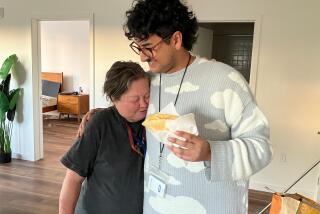Pain Victims Soften Ache of Isolation at Gatherings : Health: Members of association meet twice a month for friendship and understanding that is often elusive in daily life.
- Share via
Imagine a sharp, endless toothache, and you still have no idea how much chronic pain hurts.
But no one gripes or grimaces at this meeting of the American Chronic Pain Assn.
Spinal braces, foam cushions and canes carried into the meeting room at St. Jude’s Catholic Church in Westlake are the only visible clues that the 17 members here are suffering.
On the first and third Tuesdays of each month, they gather to talk of lives and careers shattered by nonstop pain.
They share advice on thinking past pain, exercising through pain and just living with pain.
And in two hours of joking banter, hand-holding prayer and frank confession, they accomplish together what doctors, drugs and surgery have failed to do: They make each other feel better.
“I’d be getting toward my wits’ end if I didn’t have the group,” said Gene Dedick, 75, of Thousand Oaks.
Dedick founded the Southern California division of the worldwide self-help group seven years ago after a blown Achilles tendon and several spine operations left pain shooting through his legs and back. Now there are 17 chapters in the region and nearly 800 around the world.
“We get together, we discuss our various problems, how we live with chronic pain,” Dedick said. “Anyone who does not have chronic pain has no idea of the pain and agony we go through.”
No one understands--that is a common thread of discussion for those who suffer with pain that never goes away.
Nonstop pain, they say, creates an isolating, us-versus-them mentality.
Family members get tired of hearing complaints. Co-workers are unsympathetic or ignorant. Friends drift away. Employers shun you.
“People don’t understand. And if you complain, they don’t know how to deal with it, because they want to help you but they don’t know how,” said association member Mike Taylor of Thousand Oaks.
Taylor, 53, has pieced together a multifaceted career after several back surgeries and the degeneration of his spine left him unable to walk and stricken with chronic pain.
He moves by wheelchair and travels with a specially equipped van to part-time jobs counseling teen-agers, working at a radio station and advising the city of Thousand Oaks on services for the disabled.
He pushes himself twice monthly to bring his infectious good humor and an impish love of dirty jokes to the pain association meetings.
But the pain is nearly constant, he said, and there are days when he simply cannot get out of bed.
“It’s like having a toothache,” Taylor said. “What do you do when you have a toothache? You go to the dentist. But I can’t. That’s what chronic pain is like.”
June Dube gives up her lunch hours as an executive secretary with a Thousand Oaks cosmetics firm to attend the meetings.
One of the few members able to hold down a full-time job, Dube said she was stricken five years ago with arthritis in both hips and a shoulder and with the ache of fibromyalgia burning in her muscles.
She must work, she said, because she needs the health insurance.
Her co-workers are supportive, but they can only imagine what she goes through, she said.
“It’s very difficult. I have to balance a certain amount of walking, a certain amount of sitting and a certain amount of movement. If I sit for too long and stand up, my joints are too stiff to move.”
She can’t take medicines because of a physical intolerance, and she must wake up at 5 a.m. just to stretch out the night’s stiffness and get ready for the day. At work, she must treat herself with care, she said.
“I look all right,” Dube said. “But because I’m not missing any limbs and I’m not bleeding from my eyes, people assume I’m all right.”
Some job interviewers discriminate against those who complain of chronic pain.
“These days, they will not accept you if you have limitations,” said George Wolters, 64, a former American Airlines worker disabled by a herniated disc that required several operations. “I could not find anything unless it was on a voluntary job basis.”
Many of the association’s 7,000 members joined the group not only to find relief from pain but to fight the crushing depression that often accompanies the months and years of ceaseless discomfort.
Forced from full-time work, confined to home and sometimes bed, some chronic-pain sufferers sink into despair and even contemplate suicide.
“They feel there’s no purpose to their life,” member Craig Holt said. “They become completely non-functional.”
Holt, 51, worked as a photo lab technician in the movie industry before osteoporosis and arthritis began crumbling his frame. He recently took Dedick’s place as the association’s volunteer liaison to Southern California.
“And as people become more and more isolated at home with their pain, they can feel more and more removed from society and the outside world,” he added. “They begin to think they’re the only persons in the world suffering from this.”
Some accuse chronic-pain victims of being whining hypochondriacs, association members say.
In fact, said Dr. Joshua Prager, director of the UCLA Pain Medicine Center, patients usually suffer real ills ranging from surgery-induced backaches to stress-aggravated stomach disorders.
And as pain lingers, the psychological burden grows, he said.
“It’s not just something you feel in your body; it’s an emotional experience that’s partially triggered by what’s going on in your body,” Prager said.
Drugs can block the pain, make it manageable. But they often dull the patient’s sensitivity--and they can build walls between patients and an understanding of why they hurt, he said.
“Behavior plays a major role in pain,” Prager said. “(If) we can relax, we can modulate our pain.”
At the Scripps Clinic and Research Foundation in La Jolla, doctors use behavior modification to teach patients to work past their pain, pain expert Alan H. Roberts said.
In five weeks of outpatient treatment, they are taught to stop acting hurt--no grimacing, limping or holding a painful body part. And they practice stretches and exercises that make them more mobile, independent and confident, he said.
“How much of pain can be in a person’s head? The answer is that all of it’s in a person’s head--cut a person’s head off and there’s no pain,” said Roberts, head of the clinic’s division of medical psychology. “There are a variety of reasons why people have chronic pain, some of which is clearly psychological.”
The patient often holds the key to stopping chronic pain, Roberts and Prager agreed, and self-help groups often help turn that key.
“We have a chance every day to re-create ourselves,” association member William Parker said.
After 15 years of near-constant pain in his lower spine and legs, the Thousand Oaks pharmacist had all but abandoned his career.
Then, he said, he joined the association five years ago and regained control.
The pain never ended, but he has reassembled his work to the point where he is teaching again at UC San Francisco’s School of Pharmacy, he said.
“I tell people I can be incredibly productive for about five minutes a day,” Parker told members at the meeting, squirming uncomfortably on a foam cushion.
“I produced two U. S. patents in the past year,” he said with a sly smile, “so I guess they took about five minutes apiece.”
FYI
For information about the American Chronic Pain Assn. chapter nearest you, call the group’s Sacramento-area headquarters at (916) 632-0922, or write P.O. Box 850, Rocklin, Calif. 95677.
More to Read
Sign up for Essential California
The most important California stories and recommendations in your inbox every morning.
You may occasionally receive promotional content from the Los Angeles Times.













